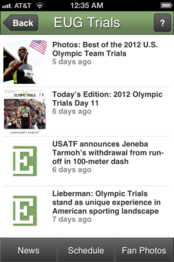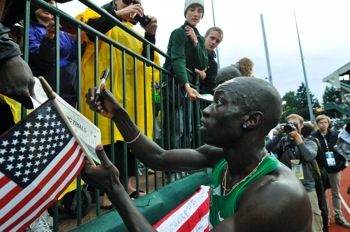Two blocks from our newsroom, 20,000 fans yelled, clapped and stomped for a world record. A former University of Oregon decathlete, Ashton Eaton, crossed the finish line in time to make history.

When Eaton grabbed a U.S. flag in celebration, Tess Freeman, a student photojournalist on our staff, captured the trials’ defining moment.
For 11 crazy days, elite track and field athletes — along with thousands of fans, hundreds of security officials, and millions of dollars in Nike marketing muscle — took over the campus.
The Emerald had three dozen students working up to 15 hours a day to keep pace. We had a lot at stake. In May, we announced the Emerald would be reinvented for the digital age. This was our first chance to show what we could do. But we had to prove it both on the web and in print. For one of the few times in our history, we published print editions — including on weekends — for 11 straight days. “The idea of failing on this platform was terrifying,” said Editor-in-Chief Tyree Harris. “We all knew we didn’t want to be that paper.”
Overall, we ended up happy with how things turned out, and our students learned a semester’s worth of lessons about professionalism, speed, and why people still covet print.
1. Prepare like an Olympian

Advertising and marketing plans started last fall, and news editors locked themselves in a room for seven hours starting in April to budget stories. “Over-preparation is impossible,” Harris said. Before the trials even began, student reporters had filed about 30 stories to preview events or highlight entertainment options for out-of-town guests. We carefully laid out the advertising and photo pages to give each day’s print issue the feel of a commemorative program. Even with all that prep work, Harris said he saw opportunities to improve communication, especially during the event, through Facebook groups, text message, and old-fashioned meetings.
2. Experiment, but don’t worry about revenue — yet
We built our first mobile app for the trials. We kept it pretty simple with three basic tabs: news, schedule, and Instagram photos taken around Hayward Field. We had a small marketing campaign and finished with about 700 unique users and about 2,500 page views. Given the circumstances, it was a solid showing. But we didn’t sell any advertising because we considered it primarily a beta test leading up to our next project: an Oregon football app. We expect that one will generate revenue.
3. Be useful

Our students produced professional-grade stories and photos. Fans loved them. But what really compelled people to pick up the Emerald: It was free and it included the daily heat sheet, which lists athletes competing in each event. On our app, the most viewed page after the launch was the schedule. It can be painful to those of us who write stories for a living, but users value utility.
4. Awesome products need more than stories and pictures
The university sponsored a scavenger hunt to encourage out-of-town visitors to tour the campus, and the winners got their own gold medal. Administrators supported the game with a major advertising campaign — which listed the scavenger hunt locations — in the Emerald and a fleet of well-trained students to distribute the newspaper. The result: We had so many empty boxes we had to increase our press run by 20 percent to 6,000.
5. Video: go live for speed
Our multimedia reporters started shooting video of athlete interviews, then edited, then posted to the web. But after a few days, they cut out the editing and posting and went
straight to live streaming. The production quality suffered, no doubt, but we made up for that in speed and efficiency.
6. Go fast and slow

Two students split up the fast-slow approach. Reporter Isaac Rosenthal posted live updates on Twitter and to the website, and sports editor David Lieberman tied together the major storylines for print the next day. But Lieberman learned that he, too, needed to post a quick “stub” — a one paragraph summary — before writing his longer print story. When he posted the stub, his story got five times more views.
7. Print: not dead yet
One Sunday I stopped a man who climbed up a dark stairway in our building to ask where he was headed. To our office, he said, to collect Olympic Trials editions he had missed. On other days, fans walked right into the newsroom to thank our students for their work and they also handed athletes our paper to autograph. We didn’t see anyone signing the app.
8. Learn to be a pro
Students worked alongside the greats in sports journalism, and they were rewarded for their ambition. Sports Illustrated’s Bill Frakes was especially gracious, chatting with photo editor Jeff Matarrese during the women’s high jump final about school, sports and careers. Dozens of other pros were equally generous. Matarrese wrote in an email after the trials: “I have tens of new connections on Facebook and LinkedIn with famous photographers who I actually know, who I can call up and ask advice or offer my assistance and help further my career.”
Ryan Frank is the publisher of the Oregon Daily Emerald, the non-profit student news organization at the University of Oregon. He previously worked for 11 years as a reporter at The Oregonian.

